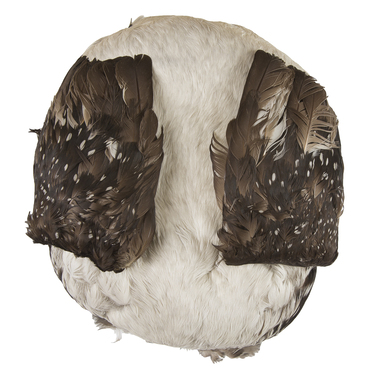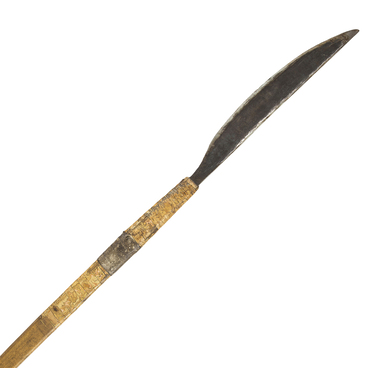An Evenk smoking pipe — umugun — is displayed in the Transbaikal Regional Museum of Local Lore. It was made in the middle of the 20th century. The stem of the pipe is made of wood while the shank is made of bone. There is a draught hole inside.
Practically all Evenks smoked pipes. Leaf tobacco came to these places from different regions. The western groups that live between the Yenisey and the Lena Rivers were introduced to it by their neighbors, and the northeastern tribes acquired it through the Russian population.
As well as tobacco, the Evenks borrowed the ganza pipe — a metal smoking pipe with a long mouthpiece and a small shank, a hollow wooden rod for smoking. Later, they were used only by women.
Along with metal pipes, homemade wooden ones were also used. The Evenks called them “omugun”, “umugun” or “umusun”. Such items consisted of a bowl for tobacco, a massive and thick shank and an attachable mouthpiece — the part that was brought to the lips.
The bowl was filled tightly with tobacco, which was then lit, so that a person simultaneously inhaled and drew smoke from the mouthpiece. The pipe was smoked slowly; depending on the size of the tobacco chamber, the process could take 20 to 45 minutes.
Evenk pipes usually had a very small bowl; thus, they were usually smoked quicker. Most often whole-leaf tobacco without any additional compounds was used; it was replaced only on rare occasions. For example, when they ran out, the Evenks could smoke tree bark crushed into small pieces. Some people scraped the soot out of their pipes after smoking, saved it, and later mixed it with the bark.
Most parts of the smoking pipe were made from tree root, most often birch tree root was used. When hunting in the field, the Evenks cut the item out of branches and made two small holes: a bowl for tobacco on top and a smaller hole for smoking on the bottom. This pipe made of improvised materials was called “nyukeme”. It was uncomfortable to smoke: the tobacco had to be pressed down with a finger all the time, so after two or three puffs it was thrown away.
Besides, the Evenks also chewed tobacco, but did not snuff it. However, this activity did not become popular.
Practically all Evenks smoked pipes. Leaf tobacco came to these places from different regions. The western groups that live between the Yenisey and the Lena Rivers were introduced to it by their neighbors, and the northeastern tribes acquired it through the Russian population.
As well as tobacco, the Evenks borrowed the ganza pipe — a metal smoking pipe with a long mouthpiece and a small shank, a hollow wooden rod for smoking. Later, they were used only by women.
Along with metal pipes, homemade wooden ones were also used. The Evenks called them “omugun”, “umugun” or “umusun”. Such items consisted of a bowl for tobacco, a massive and thick shank and an attachable mouthpiece — the part that was brought to the lips.
The bowl was filled tightly with tobacco, which was then lit, so that a person simultaneously inhaled and drew smoke from the mouthpiece. The pipe was smoked slowly; depending on the size of the tobacco chamber, the process could take 20 to 45 minutes.
Evenk pipes usually had a very small bowl; thus, they were usually smoked quicker. Most often whole-leaf tobacco without any additional compounds was used; it was replaced only on rare occasions. For example, when they ran out, the Evenks could smoke tree bark crushed into small pieces. Some people scraped the soot out of their pipes after smoking, saved it, and later mixed it with the bark.
Most parts of the smoking pipe were made from tree root, most often birch tree root was used. When hunting in the field, the Evenks cut the item out of branches and made two small holes: a bowl for tobacco on top and a smaller hole for smoking on the bottom. This pipe made of improvised materials was called “nyukeme”. It was uncomfortable to smoke: the tobacco had to be pressed down with a finger all the time, so after two or three puffs it was thrown away.
Besides, the Evenks also chewed tobacco, but did not snuff it. However, this activity did not become popular.



